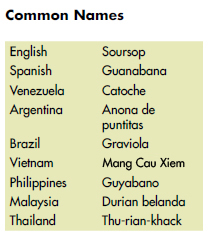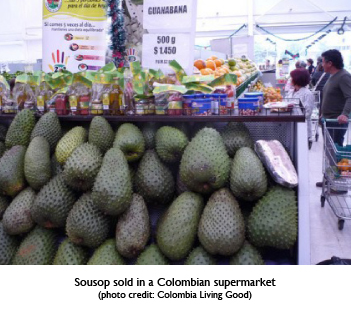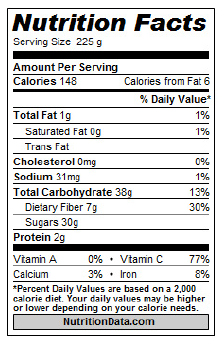Prized for its delectable taste and juicy pulp, soursop is a popular fruit in South America and in some parts of South East Asia. The fruits are consumed fresh but are mostly grown commercially to produce juice, puree, ice cream, sorbet, and other processed products. Soursop is rich in ascorbic acid, phosphorous, calcium, and other micronutrients. Some sources even claim that it has anticancer properties.
 Soursop (Annona muricata), known as graviola in Brazil, originated from Central American lowlands and was documented by Spanish historian Gonzalo Fernandez de Oviedo y Valdes in 1526. He and other Spanish explorers were responsible for spreading the fruit around the world. It is now commercially cultivated in the tropical Americas and in small orchards in Southeast Asia, Philippines, India, Hawaii, Africa, and other Pacific Islands.
Soursop (Annona muricata), known as graviola in Brazil, originated from Central American lowlands and was documented by Spanish historian Gonzalo Fernandez de Oviedo y Valdes in 1526. He and other Spanish explorers were responsible for spreading the fruit around the world. It is now commercially cultivated in the tropical Americas and in small orchards in Southeast Asia, Philippines, India, Hawaii, Africa, and other Pacific Islands.
Plant Description
Soursop is a tree, reaching a height of 7.5-9m, low-branching, and slender. Young branchlets are hairy and rusty in color. The oblong leaves grow alternately, are normally evergreen, smooth, glossy, and dark green on the upper surface while light green underneath, and are 6.25-20cm long and 2.5-6.25cm wide. The bark is considered slightly toxic and contains potentially poisonous compounds like anonaine, muricine, and hydrocyanic acid. The root system consists of a 1.5-1.8 m long tap root and abundant lateral roots. The tap root does not grow as deep as other tropical fruit trees like mango.
The flowers are hermaphroditic and appear individually anywhere on the trunk, branches, or twigs. They have short stalks, are long, plump, and conical in shape, reaching 4-5cm long. The 3 outer petals are yellow green, fleshy, and slightly spreading while the 3 inner petals are thinner and pale-yellow.
Soursop produces the largest fruit among the Annonaceae family, ranging from 10-30cm long and up to 15 cm wide with a weight of 4.5- 6.8 kg. The fruit is ideally oval or heart-shaped but can be lopsided or curved due to poor pollination or insect injury.
The compound fruit is covered with an inedible dark green leathery skin that becomes yellow-green, soft, thin, and tender when ripe. The skin is covered with protruding soft, elongated, curved, and pliable spines that easily snap when the fruit is fully ripe. The cream-colored inner surface of the skin is granular and separates easily from the flesh.
The snow-white fruit segments are fibrous and juicy, surrounding the soft-pithy core at the center. The pulp has unique taste: a pleasant blend of sweet and sub-acid flavour with a musky pineapple-like aroma. Most of the tightly-packed flesh is seedless, though fertile segments contain a single oval, smooth, hard, black seed 1.25-2 cm long. A single fruit may contain as little as 12 dozen seeds to more than 200.
Common Varieties and Cultivars
Varieties are often classified according to taste: sweet, sub-acid, and acid. Sweet and sub-acid ones can be consumed fresh or processed, while acid varieties are solely used for processing.
 Sweet: Guanaba Azucaron (El Salvador), Guanabana Dulce (Dominican Republic),
Sweet: Guanaba Azucaron (El Salvador), Guanabana Dulce (Dominican Republic),
Sub-acid: Aguinaldo (Philippines), Davao (Philippines)
Acid: Guanaba Acida (El Salvador)
Propagation
Although seeds can be used to propagate soursop, propagation is commonly done asexually by marcotting, grafting, or budding. Preferred characteristics of mother trees can be passed down to asexually propagated plants.
To improve soil texture, the land can be plowed at least twice then harrowed with organic manure until desired planting condition is attained. Layout the field by placing stakes 4-7m apart. This spacing would require 204-625 planting materials to fill a hectare. Make sure that holes are wide and deep enough to accommodate the root system of the seedlings. For newly opened land, burn under-brushed branches and twigs before the holes are dug.
Fertilization and Irrigation
Fertilizer application promotes plant growth, ensures that young trees are strong and sturdy, and improves fruit production. It is recommended to apply 100-150 grams of ammonium sulfate one month and six months after planting. Complete fertilizer should be applied annually in increasing doses until trees bear fruit, up to 250-300g. The amount is also increased in each succeeding year of fruiting to 1.5-3.0 kg of complete fertilizer (14-14-14) and plus 200-300g of muriate of potash (0-0-60).
For rapid growth of the soursop trees, irrigation is commended due to their shallow root system. In minimal conditions, it can tolerate dry soil better than other fruit trees. However, prolonged drought may cause the plants to shed leaves.
Pruning
Pruning improves interior aeration of the tree, allowing more sunlight to permeate and stimulate fruit yield. Excessive branches should be pruned, especially defective ones that grow downward or interlace.
Diseases branches, dried twigs and water sprouts should likewise be pruned to avoid spreading of diseases.
Pest and Diseases
For more plant health information, including diagnostic resources, best-practice pest management advice and plant clinic data analysis for targeted crop protection, visit CABI’s Plantwise Knowledge Bank.
Common soursop pests include:
1. Nematodes attack the plant roots and during advanced stages of growth, causing the whole plant to wilt. These can be controlled by applying nematicide at the base of the tree.
2. Mealy bugs suck the sap of young leaves and fruits, turning them yellow and stunting growth. Malathion, Methyl Parathion or Azodrin at manufacturer’s recommended dosage can be sprayed to control the pest.
3. Carpenter Moth larvae bore into the inner part of the wood where they feed and grow, hampering the flow of nutrients. Physically removing and burning damaged twigs is the best way of controlling the pest.
4. Scale insects feed under the leaves, sucking the sap. The recommended dosage of Malathion is enough to control the pest.
5. Oriental fruit fly damage leads to fruit rot. Fruit bagging is an efficient way to reduce fruit fly damage.
6. While ants do not directly damage the tree, they form a symbiotic relationship with mealy bugs and scale insects. Malathion, Methyl Parathion or Azodrin can also be used to control ants.
Common diseases include:
1. Root fungi (Fomes lamaoensis) causes decay, leading to the collapse and death of the tree. Trees that succumb to infection should be removed and burned.
2. Pink disease caused by fungus Corticium salmonicolor infects twigs and branches, which collapse and die. A pink fungal growth on the bark manifests when the disease is present. Common control is through the physical removal and burning of infected twigs, branches, and leaves. Spraying the tree with copper fungicide also protects further infection.
3. Flowers and fruits affected by anthracnose fungus may cause them to fall from the tree. Seedlings and young shoots may also be affected by the fungus. Fungicides Maneb, Captan, or Vitigran Blue may be used for control.
Harvesting
Soursop trees bear fruit 3-5 years after planting. The tree flowers throughout the year but peaks on May to June and the fruit ripens on November to December. It is recommended to harvest the fruits when fully mature, as prematurely picked fruits are poor in quality. Mature fruits are shiny green or yellow green and the spines are quite far apart. Fruits do not mature at the same time and requires selective harvesting.
Postharvest
The harvested fruits should be placed in containers lined with soft materials, such as newspaper or rice straw. Mature fruits have tender skin and should be handled with care. It takes 3-5 days for the fruit to ripen after harvest. Those meant for fresh consumption must be sent to the market immediately. Fruits for processing can be placed in a dry area under normal temperature until ripe. While refrigeration can extend shelf life by a few days, it causes skin to turn black. This doesn’t affect fruit quality but might scare off potential buyers.
Commercial food operators add water to the flesh to reduce viscosity, citric acid to adjust the pH to 3.7, and sugar to 15%. The pulp is then frozen to or sterilized to be used for dessert, syrup, soup, and other value-added products.
Soursop is a nutritious fruit, rich in ascorbic acid, potash, phosphorous, and calcium. With an edible portion of 62-85%, the crop is very viable for fresh consumption and processing.
Immature fruits are cooked as vegetables or soup in Indonesia. In northeastern Brazil, they are roasted or fried. Upon boiling, the immature fruit is tender with the aroma and flavor of roasted corn.
Seeded soursop has been canned in Mexico and served in Mexican restaurants in New York and other northern cities. In Brazil and Puerto Rico, soursop juice is popular. The seeded pulp is pressed to extract the juice, which is then stirred with milk or water and sweetened. Processing factories in Puerto Rico place hand-peeled and cored fruits in a mechanical pulper. The machine’s nylon brushes press the pulp through a screen, separating the juice, seeds, and fiber. Guatemala produces soursop flavoured carbonated beverages while the West Indies have fermented soursop cider. Soursop custard is enjoyed in the Dominican Republic made from cooking the pulp with sugar, cinnamon, and lemon peel. The Philippines also have vacuum concentrated canned juice.
Other uses
Aside from the fruit, other parts of the soursop tree have different uses. The pulverized seeds are traditionally used as skin astringent, an herbal substitute to purge intestinal worms, and an anthelmintic against head lice and other topical parasites. It can be also used as plant pesticide.
It has been reported that the leaves induce perspiration, has tranquilizing and sedative properties, can hasten the healing of wounds, prevent scarring, and provide alternative treatments for pain, inflammation, fever, eczema, and other skin diseases. Meanwhile, bark and roots are used as alternative treatments for diabetes and convulsion.
Research and Development
A study conducted by the Philippine Department of Science and Technology (DOST) concluded that unripe soursop have more flavonoids, such as acetogenins, than ripe ones. Lab experiments show that flavonoids may help prevent a variety of diseases: cancer, allergies, and infections.
It should be noted that like many plants, soursop has shown promise in laboratory tests as a possible agent against cancer. However, these experiments are all done in vitro and no significant clinical drug trials have been done to test the actual effectiveness of soursop in treating cancer. Still, soursop is a nutritious fruit and is a good source of vitamins and minerals required for a healthy diet.
References
TFNet Database
Morton, J. 1987. Soursop. p. 75–80. In: Fruits of warm climates. Julia F. Morton, Miami, FL.
De Quiros Pinto, A.C. 2007. Soursop. Fertilizing for High Yield and Quality Fruits of Brazil.
www.hort.purdue.edu/newcrop/morton/index.html
Bureau of Plant Industry Production Guide [Retrived from http://www.bpi.da.gov.ph/bpioldsite1/guide_guayabano.php]
Brown, W. H. 1951. Useful Plants of the Philippines. Bureau of Printing Press, Manila. Volume 1. pp. 541-543.
Bureau of Agricultural Statistics, Department of Agriculture, Philippines. 2003. Crop Statistics.
Coronel, R. E. 1983. Promising Fruits of the Philippines. UPLB. Pp. 235-246.
Cultural Directions for Philippine Agricultural Crops. 1972. BPI. Vol. I, Fruits. Pp. 135-136.
Samson, J. A. 1980, tropical Fruits (Tropical Agricultural Series). Pp. 216-218.
Technology for Guyabano Production. 1985 (Mimeographed Handouts). Research Division, BPI, Manila.
de Leon, DR. 2012. A treat of guyabano. http://www.bar.gov.ph/digest-home/4608-octdec2012-guyabano
Love, K. and Paull, RE. 2011. Soursop. College of Tropical Agriculture and Human Resources (CTAHR). http://www.ctahr.hawaii.edu/oc/freepubs/pdf/F_N-22.pdf
Cropsforthefuture.org
www.varahonda.com




I am from SOFRI, Vietnam. The Vietnamese fruit plant is exactly Mang Cau Xiem or Mang Cau Gai.
Thank you. We’ve incorporated the changes.